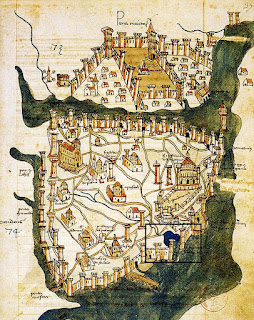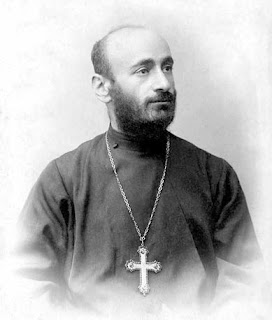Harbour of Theodosius, The moments frozen in time, 400-1200 AD
Let us continue the Byzantium thread. This time we would
go further in time to about 8th to 10th century AD to the
Harbor of Theodosius where the biggest medieval ship wreck assemblage was
unearthed in the last decade. The moments frozen in time…
At the beginning Golden Horn was favorable for docking ships. As the trade grew after Constantinople was made the capital of Eastern Roman Empire it was supplemented by two harbors on that side and later two facing the Sea of Marmara. They were named after the ruling emperors of the time. Theodosius built one of those facing the Marmara Sea in 4th century.
 |
| Map by Cristoforo Buondelmonte, 1422 |
It was built at the mouth of Lycus (Bayrampaşa)
stream. There were large storehouses close to the Harbour of Theodosius called
Granaries of Alexandria and Theodosiana (Horrea Alexandrina, Theodosiana).
Therefore it must have been a major commercial harbor where cereals were
brought from Alexandria. At first seagoing ships of large capacity brought
grain to the city but the currents and winds of the Hellespont which Tenedos
(Bozcaada) is notorious of, kept the ships at bay. Later Justinian built
granaries on the island of Tenedos from where ships of smaller capacities were
transporting grain to the capital. This continued until 641 AD when the Arabs
conquered Egypt the source of grain. After that Theodosian harbor declined in
activity yet it continued to serve as a harbor.
Some frozen moments are warmed for you by yours very
truly from the artifacts found at the wrecks of the Harbor of Theodosius at
Yenikapı:
Sometime between the 9th and 10th century small, large all various sizes of merchantmen and long, slender galleys (which are designed for speed and maneuverability) docked in the Harbor of Theodosius. The workers used timber to form the planks that are cut down from black pine (pinus nigra) and for the frames they preferred oriental plane or elm.
Horses were pulling the carts loaded with heavy material from the ships.
A fishing boat was in the harbor tied to a pier. It looked very similar to the traditional fishing vessels still seen in Istanbul.
A medium merchantman with lateen sails was approaching the harbor with a heavy cargo. Large amounts of baked-clay brick, mortar (a mixture of pitch, asphalt and soft mud or clay) and marble from Proconnesos (Island of Marmara, namely “marmar” which means marble). Maybe some of those materials would be used to repair the Theodosian walls, which had been damaged by the frequent attacks by enemies of all sorts.
In the food preparation quarters of a small merchantman there were a cooking stove and a pot. At the same time the sailors were drinking fine Thracian wine from the tankards after a restless, stormy Blacksea trip, the deckboy was filling the glass goblet of the captain. The vessel traded with the Bulgars and Khazars on its way to Crimea. The captain had cherries after that meal when the time must have been June or July the months the cherries ripen in that region. The weather seemed to go fine that day but there were storm clouds gathering over the Marmara Sea. The captain ordered the evacuation of the vessel, before the wind and waves swallowed the ship. It’s the ever surprise summer storms (called Kaçak in Turkish) of Marmara.
A large merchantman was also at the dock supplying the merchants with salted anchovy from the Blacksea, feeding the population of Constantinople.
Now we leave the port of the 9th century to
continue our journey in time.
Teaching ship building to foreigners was banned. So
within the empire it’s perceived importance is clear. There was this general principle
‘no enemy should own anything that will make him superior to us’. In the last
quarter of the 10th century, the Epanagoge (“Return to the point” is a Byzantine
law book) states: ‘Whosoever teaches the barbarians to build ships will be
liable to capital punishment’.
As time went on the harbor was abandoned as a result
of silting after the 12th century. It used to be a dumping ground
for rubble where the remains of a 12-13th century church were found.
After 1261 Jews settled in this area. It came to be known as Vlanga and they
primarily were involved in the leather tanning business. In Langa Bostanı
(Langa vegetable gardens) where it was used to be known then, locals mostly
non-muslim grew vegetables and fruits.
 |
| Yenikapı excavation site |
Now Harbor of Eleutherios (Theodosius) sits beneath
Yenikapı neighborhood in Istanbul where it was excavated in the last decade. During
the excavations the traces of the city wall of Constantine the Great and 37
shipwrecks dating from 5th to 11th centuries AD were
uncovered. It’s thought storms, floods, possibly a tsunami and sudden “kaçak”
summer storms of the Marmara Sea might have sunken the ships.





Comments
Post a Comment